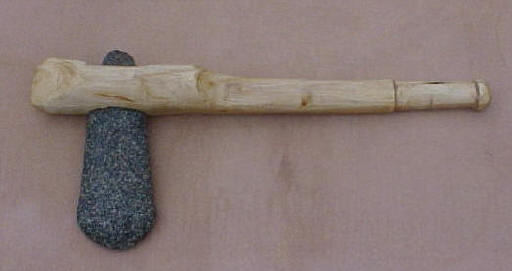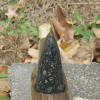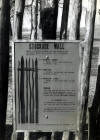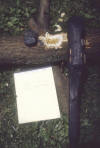

(up-dated 12/April/2017)

SOMETIMES, AN AXE IS JUST AN AXE
Larry using a celt at the Rabbit Stick Rendesvous U-tube http://www.youtube.com/watch?v=5zObOcOdUWo&feature=related

These two celts were completed on December 1st,
2008. They are replicas to be used in a documentary. The darker one on the left
is made from dark granite and has a dogwood handle.
Stone: length 9 1/2 " (24cm) width 3 5/8" (9.1cm)
thickness 1 3/4"(4.5cm) Handle: length
20 7/8" (53cm) height 3 3/8" (8.5cm) thickness 3 3/4" (9.6cm)
The one on the right is a piece of granite but with more color than the other. It has a hackberry handle. Stone: length 9 7/16" (24cm) width 3 7/8" (10cm) thickness 2" (5cm) Handle: length 23 3/8" (59.4cm) height 3 1/2" (9cm) thickness 3" (7.6cm)
(Photos
by David Cox, Click photos to enlarge)
Larry's axe demo at Rabbit Stick '03
This celt was finished November 7th, 2008. It's made of basalt and has
a hackberry handle.


This basalt celt was finished November 8th, 2008 and is mounted in a dogwood handle.
Larry uses "Big Mama" on a mountain poplar log at Rabbit Stick '06. The handle broke so it's back to the drawing board.




(Photos by Tom and Merry O'Brien)
Rabbit Stick 2007. The handle breaks again. The shorter handle gives more control. So, it's off to make a stronger, shorter handle.
Here are some of the axes, celts,
and other ground stone tools, or stone tools, Larry has made and used over the last 20 years.
If you're looking for stone celts, stone axes, groundstone axes, or groundstone celts, made from granite, diorite, greenstone, or quartzite, you should find this site interesting.
Ground stone axes and celts are made by pecking and grinding. A fine-grained granite, greenstone, basalt, or diorite is battered with a flint hammer until it is worked into a rough shape. This is rough work and requires a lot of persistence and time. The work is especially hard on muscles and elbows. Larry's axes and celts take from 4 to 25 hours to make, depending on size and material. After the axe, ground stone tool, or celt is pecked into shape, it must be sharpened on a sandstone slab. This may take minutes to hours. When completed, it will serve as an effective wood-working tool for a very long time. Following, are some ground stone axes and celts. To see Larry's newest ground stone celt in the process of being made, go to EXPERIMENT IN PROGRESS.
![]() (Photo
LK)
(Photo
LK)
LARRY'S FIRST CELT
This is the celt
Larry made for the Calahan pit house project at Cahokia Mounds in
1982. It was later broken by a 9 year old boy who was chopping a 6"
black locust log, during Rediscover Cahokia, a few years later. Even
broken specimens can tell us much about these wood-working tools.
Setting the first of two large gates to protect the Calahan pit house (in the background) and the earlier Cahokia pit house reconstruction (on the right). From the left are : Larry, Tally Evans, and Gene Harrod, great Cahokia Mounds volunteers.

The stockade at the old Cahokia Mounds Museum. It was built in 1983 to protect the Calahan Pit House from vandalism. The 400 lb. gates were done, with stone tools, by Larry and a few other volunteers.

 (Photo
Pete Bostrom)
(Photo
Pete Bostrom)
GLEN'S CELT
This ancient celt is
owned by Glen and is one of the largest celts in Illinois. It weighs
about 25lbs. and is 18 1/4 inches long. Larry believes that such large
celts are not for felling trees but are used when the tree is down.
Dugout canoes would have been a perfect place to use such large celts.
![]()

DICKSON MOUNDS CELT
The celt pictured
above, was broken while cutting an 8 inch, black locust log at Dickson
Mounds Museum in Lewistown Il,July 11th 1993. When it broke, an employee ran out of
the museum thinking someone had fired a shot from a rifle. Larry was
swinging the celt so hard that his feet were leaving the ground. This
was an experiment to see what size celt should fit to what size
handle. As you can see, this celt needed a smaller handle. Only
through experiments like this, can we determine the correct ratio of
celt size to handle size. Even though it's a shame to break a tool
that took many hours to make, it's important to note how and why it
broke. If a tool can't do the job, it must be modified until it can do
the job or be discarded.
![]()
GRAHAM CAVE Grooved
Stone AXE
Axes are made with
a groove around the handle to accept the haft. This axe was made in
2002 for Graham Cave State Park in Missouri. It was pecked with a
flint hammer and ground on a sandstone slab like other ground stone
tools. It was hafted by steaming and wrapping the ash handle around
the stone and then wrapping the handle with twisted, deer, rawhide.
This is a full-grooved axe. This type was used for thousands of years
until the 3/4-grooved axe became popular. The 3/4-grooved axe had an
advantage over the full-grooved in that a wedge could be set between
the stone and handle to tighten the stone in the handle when it became
loose. Full-grooved axes had no such advantage. Celts were the better
hafting system because they allowed the stone to seat every time it
hit the log, thus wedging the stone tighter and tighter in the wooden
handle.
![]() (Photo
LK)
(Photo
LK)

3500 CELT
This celt has cut
3500 limbs and trees from 1/2 inch to 12 inches in diameter. It's
never been resharpened!! This is one of the celts used in the
construction of the Woodhenge at Cahokia Mounds. The Woodhenge is a
solar observitory made of 24 black locust logs and 24 red cedar logs
about 10 to 12 inches in diameter. They were all limbed and cut to
length using celts. The work was done by several Cahokia Mounds
volunteers. The bark was also removed using celts and clam shells. The
center pole was set by the volunteers and the remainder were set by
site maintenance personel. The center pole could have been raised with
as few as 3 people. The secret is to dig the hole with an "extraction
ramp" leading to the deepest part of the post hole. "Installation
ramp" may be a better term. It was plumbed by using a rock tied with a
string and letting it hang. The post was then shifted until it's
center was divided by the string. The same was done at 90 degrees.
![]() (Photo
LK)
(Photo
LK)
BROKEN CELTS
Broken celts have
much to tell us. Admittedly, we'll have to break many of them to learn
their secrets but these two can give us some hints. The top one was
broken at Dickson Mounds Il. It was the result of an experiment to see
if an oversized handle could exert too much pressure on the stone and
break it. That is what happened and it told Larry that the handle
should be smaller next time.
The lower celt was broken
by a 9 year old boy while cutting a 6 inch log at Rediscover Cahokia.
It broke as the result of "side slap". That is, the handle twisted in
the hands and the stone was "knapped" as it slammed against the
opposite side of the cut. As a result, Larry makes his handles oval
(vertically) rather than round. The handle allows a better grip that
helps prevent "side slap".


This celt was given as a prize at the 2007 Archaeology Day, at Cahokia Mounds. It was won by Earl Fey, the chairman of the event. It was completed in June, 2007.
This celt was made for David Wescott and was pictured on the cover of The Bulletin of Primitive Technology (Fall 2007 issue #34). It was made in August of 2007.